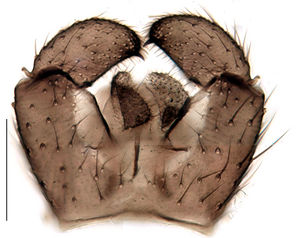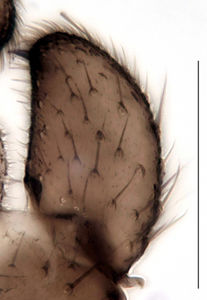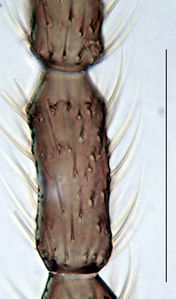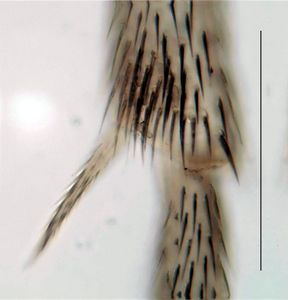Trichosiopsis subopaca
Ordo: Diptera
Familia: Sciaridae
Genus: Trichosiopsis
Name
Trichosiopsis subopaca unpublished
Type material
Holotype: ♂, 14.5.–27.5.2014, Malaise trap, leg. Olberg, bf-sci-00395 in NHMO
Type locality
Norway, Vestfold, Larvik, Småås
Barcoded material
| Stadium | Country | Province | Locality | Habitat | Method | Date | Collector | Collection Number | Collection | Latitude | Longitude | Elevation (m) |
|---|---|---|---|---|---|---|---|---|---|---|---|---|
| 1 ♂ (holotype) | Norway | Vestfold | Larvik, Småås | Malaise trap | 14.5.–27.5.2014 | Stefan Olberg | bf-sci-00395 | NHMO | 56.2111111 | 10.01 | 75 | |
| 1 ♂ | Norway | Vestfold | Larvik, Farmenroeysa E | Malaise trap | 14.5.–27.5.2014 | Stefan Olberg | bf-sci-01382 | NHMO | 59.229 | 10.025 | 235 | |
| 1 ♂ | Estonia | Lasila, pollusaar no. 104 | Malaise trap | 9.5.–31.5.2016 | Olavi Kurina | ZFMK-TIS-2613956 | ZFMK | 59.278638 | 26.28527 | 112 |
Other material studied
Sweden: 1 ♂, Småland, Nybro, Alsterbro, mixed forest, Malaise trap, Swedish Malaise Trap Project, 15.5.-20.5.2005, NHRS PKHH.
Description (male)
Head. Eye bridge 2 rows of facets. Antenna unicolour. LW-index of 4th flagellomere 2–2.35; neck 0.3–0.45 × segment width; transition of basal part to neck pronounced. Colour of neck unicolour. Antennal setae shorter than segment width, or as long as segment width; of normal strength; sparse; adjacent. Palpus pale; short; palpomeres 2. First palpomere thickened; with 1 setae; with only sparse sensilla. Second palpomere globular. Thorax. Colour brown, or bright brown. Notum unicolour. Thoracic setae normal; brown. Posterior pronotum setose. Postpronotal setae 1–2; fine. Mesothoracic sclerites bare. Legs. Colour yellow-brown. Hind coxa of same colour as femora. Setae on front coxa black. Front tibial organ as patch of setae; dark; front tibial organ not bordered. Tibial setae on hind legs weak and inconspicuous. Tibial spurs of equal length. Claws untoothed. Wing. Wing slightly darkened; with weakly developed anal lobe. Wing membrane without macrotrichia. Wing venation weak, with faint stM. M-fork of normal shape. R1 ending clearly before base of m-fork; posterior veins bare; bM bare; r-m with few setae; bM:r-M 1.05–1.3; st-Cu:bM 0.15–0.4; R1:R 0.9–1.2; c:w 0.7–0.85. Halter darkened; long. Abdomen. Abdominal setae weak; on tergites black; on sternites black. Hypopygium concolour with abdomen; LW-index 0.55–0.75. Base of gonocoxites with weak setae; gonocoxites narrowly separated; inner margin of gonocoxites narrowly U-shaped; inner membrane of hypopygium bare; ventral margin of gonocoxite with short setae. Gonostylus globular; LW-index 1.8–2.2; Inner margin straight; apex equally rounded. Apical tooth present; without internal structure; strong; LW-Index 1.7–2. Awl-like setae long; present beneath apical tooth. Megasetae absent. Whiplash-hair absent. Tegmen 0.7–0.9 × longer than broad; rectangular with rounded edges; without special features; central process absent. Length of ejaculatory apodeme/hypopygium 24–40 %; base of ejaculatory apodeme absent. Field with aedeagal teeth inconspicuous. Measurements. Body size 1.6–1.9 mm. Wing length 1.7–2 mm.
Diagnosis
Trichosiopsis subopaca appears to be like a minute version of Leptosciarella opaca, with which it shares the reduced palpi, the lacking macrotrichia on the posterior wing veins and the elongated awl-like setae around the apical tooth. It is only half the size of Le. opaca, from which it can be also distinguished by the more reduced palpi.
DNA Barcoding
The COI sequence is assigned to BIN BOLD:ACD8487 (average distance 0.00%, max. 0.00%, n=2, K2P: 13.00%).
Etymology
lat. sub = under; opacus = dark, shady. The name refers to the similarity with Leptosciarella opaca.
Discussion
Due to the superficial similarity with “Leptosciarella opaca”, which needs to be placed in a different genus (and is therefore not combined with Trichosiopsis), it might seem likely to place this species also outside of Trichosiopsis. Epidapus or Trichodapus would perhaps be other options. However, the similarity with these genera is probably only analogous, because it was not confirmed by DNA comparison. The available DNA sequences from Norway indicate a relation to species of the Trichosiopsis viatica group. The nearest neighbour of the BIN of Tr. subopaca is Tr. viatica. Like Trichosiopsis reducta or Trichosiopsis viaticella, it appears to be another miniaturized species in the Tr. viatica group. Despite of the reduction of various typical characters, the presence of setae on the posterior pronotum, which is not found in the much larger Le. opaca, is another indication that the species belongs to Trichosiopsis. The elongation of the halteres is probably only a side effect of miniaturization and of little phylogenetic value.
Distribution
Estonia, Norway, Sweden.
Images
|






